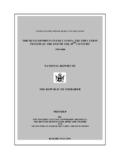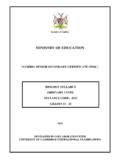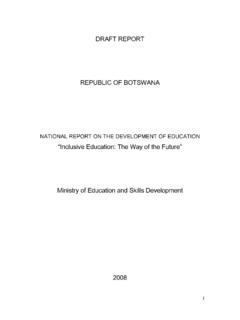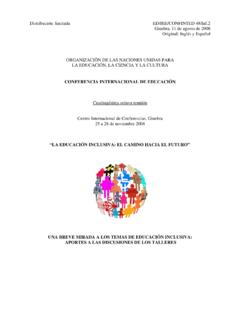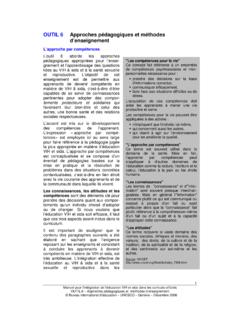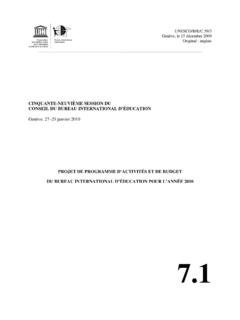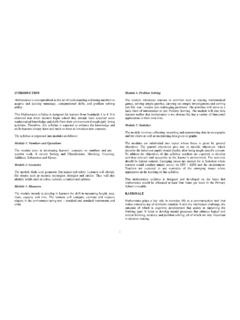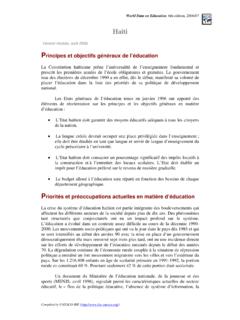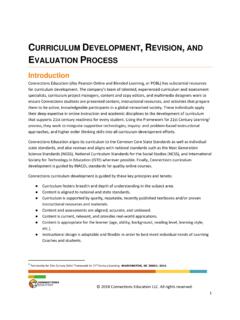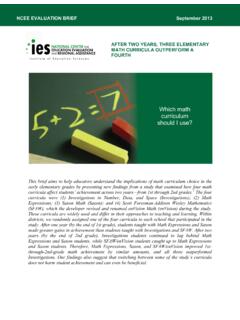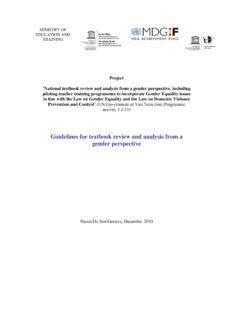Transcription of Educational Reform and Curriculum Change in China: A ...
1 Educational Reform and Curriculum Change in China: A Comparative Case Study by Zhou Nanzhao Zhu Muju Assisted by You Baohua Gao Xia Wang Wenjing Zhao Li Prepared for International Bureau for Education Completed in December 2006, and revised in April 2007. CONTENT. List of figures, iii Introduction ..1. 1 An Overview of the Education System in The Education System and Basic Development of a Legislative The Development of Private/Non-governmental The Schools Management System of Educational School/college-Admission and Graduates Employment System ..8. Development of Non-formal Education and Lifelong-Learning System ..9. Other Aspects of Educational Development ..9. 2 Systemic Educational Reforms ..11. Universalization of 9-Year Compulsory Education ..11. Expansion of Vocational-technical Education at Upper Secondary and Higher Expansion of Higher Education ..18. Diversification of Sources of Financing of Education ..19. Decentralization of Educational Administration and Teacher Education Policy Change .
2 20. The Open-Door Policy in Education: International Exchange and Cooperation ..20. Implementation of New-Century Qualities Education Programme ..21. 3 Basic Education Curriculum Background ..22. Goals of Curriculum Reform ..22. Policy Formulation for Curriculum Experimentation in Curriculum Improving Curriculum Structure for Diversity and Flexibility in Education ..26. Redesigning Curriculum Decentralization of Curriculum Management ..36. Curriculum Teacher Professional Development for Curriculum Reform ..45. 4 Problem Areas and Remaining Rural Areas Demands Greater Relevance of Curriculum Content and Different Strategies in Curriculum Reform The Need for More Diversified Curriculum Teachers Need Long-term Capacity Building and Professional Learning to Be Curriculum Implementers and Learning Facilitators ..49. Prevalent Examination-driven 5 Conclusion and Setting Relevant Educational Aims and Curriculum Goals is Essential ..51. Three Main Forces Contribute to the Success of Systemic Educational and i Curriculum Shift toward Learner-centered Curriculum Framework as a Major Breakthrough of Curriculum Reform in China.
3 52. Better Use of Instructional Time and Reduced Learning Load for More Active Evidences of Successes and References ..56. ii List of figures, tables Figures Figure 1: The Education System in China ..5. Figure 2: Proportion of vocational education at upper secondary level (1996-2003)..17. Figure 3: Percentage of lower-secondary teachers attaining required Educational attainment level, 1998-2006 ..20. Figure 4: Structure of Senior High School Figure 5: Examples of Curriculum Content of Specific Subjects ..33. Figure 6: To what degree do you agree to the conceptual principles and approaches to Curriculum design? ..38. Figure 7: To what level do you think the Curriculum standards have been implemented? ..39. Figure 8: What do you think of the approach to Curriculum objectives in term of knowledge and skills, process and method, and attitudes and values? ..39. Figure 9: To what degree do you think the instructional advices in the Curriculum standards will help facilitate student active, inquiry and cooperative learning?
4 40. Tables Table 1: A Statistical View of Education System in China (2005) ..6. Table 2: Boys' and Girls' Enrollment Rates in Elementary Schools (1998-2005)..9. Table 3: Percentage of Dropouts in Elementary School by Gender (1998-2005)..10. Table 4: Promotion Rates of Elementary School Graduates (1998-2005) ..10. Table 5: Percentage of Primary School Teachers Having Required Educational Attainment Level (1998-2005)..10. Table 6: Weekly Class Hours and Annual Week Days: China vs. Other Countries/. Regions ..28. Table 7: Percentages of Total Class Hours for Respective Subjects in 1-9 Year Compulsory Education, Table 8: Students' Performance in Table 9: Grade 1-9 Curriculum Structure in Some Countries & Regions ..43. Table 10: 2001 Compulsory Class Schedules & Rate in China (Jun. 2006) ..44. Table 11: Global average of annual instructional time, by grade level and time Table 12: Regional average yearly instructional time by grade level in iii Introduction In the broad context of socio-economic changes and as an integral part of systemic Educational Reform , school Curriculum Reform in China has been under way after 1996.
5 The breadth and in-depth of the one-decade Curriculum Change has been unprecedented since the founding of the People's Republic of China in 1949 though there had been seven major reforms in school Curriculum in previous years. Never before has a central government-guided Curriculum Reform in China been so open to research findings and practical experiences from international community on the one hand, and had so active participation by local community including teachers, students, parents and science/business sectors on the other. The Reform began with a national survey study, organized by the Education Ministry Development of Basic Education during July 1996 and the end of 1997, on the implementation of the 1992 Compulsory Education Curriculum Scheme, involving more than 16,000 students, over 2,000teachers and principals in 9 provinces, as well as leading officers in the Education, Science-Health Committee of the national Political Consultation Council.
6 The Curriculum Reform was also based on comparative studies by academic community on Curriculum development. Experiences and strategies of other countries including UK, USA, Canada, Germany, Japan, Australia, south Korea, Thailand, Russia, Sweden, Finland, New Zealand, India, Brazil and Egypt, in an attempt to comprehend benefit from worldwide Reform efforts in improving basic education Curriculum . Therefore a comparative study of schools Curriculum Reform in China is most meaningful, on the one hand, to facilitate better understanding of the largest education system in the world and its system wide Reform in context of drastic and profound socio-economic, political and cultural changes, and on the other, to develop broadened vision and research-based conceptual frameworks of school Curriculum Change as an effective strategy in achieving the goal of worldwide campaign for Education for All (EFA) in over-all improvement of quality in education at all levels.
7 For a comprehensive analysis of the Chinese experiences in Curriculum Change as part of Educational reforms for Quality EFA, an International Comparative Study on Educational Reform and Curriculum Change : The Chinese Case was commissioned by the Capacity Building section of UNESCO International Bureau of Education to the Chinese Focal Point of the Community of Practice in Curriculum Development. The main objective of the study is the following: z To develop an in-depth policy analysis of most recent (ten years'). Educational system-wise reforms, which have had implications for major 1. changes of Educational content and method in the country in early twenty-first century; and z To identify the Curriculum dimensions of processes and results in attaining a high quality and equitable basic education in regards to EFA. goals, for development of an inter-country or inter-regional comparative perspectives in cooperation with a counter-part in Latin America.
8 Specific Objectives include: z To examine the societal and Educational rationales, objectives, scope, and content of education systemic reforms in the last ten years or so, which have had impacts on the quality of basic education in light of EFA. goals;. z To analyze the implications of debate, in the process of Educational reforms, on the concept of equity and quality for Change of Educational content and method in relation to EFA goals;. z to analyze the visions of the Curriculum that inform Basic Education and the changes in Curriculum policy, structure, content and management in the last ten years or so in view of EFA goals;. z to present an evaluation of the Curriculum changes as integral part of he system-wise Educational Reform ; and z to identify an agenda of concerns and themes that relate to capacity building especially of teachers for professional development in view of the Curriculum changes in achieving EFA goal of over-all improvement of quality in education.
9 The comparative study expected to achieve multiple outcomes: z A research-based study report, which could be published by IBE, on Educational Reform and Curriculum Change in China: A Comparative Case Study z Comparative and international perspectives developed of the broad socio-cultural context and the complexity of the process of Curriculum Change as integral part of systemic Educational Reform propelling EFA in developing countries z evidences of impacts presented of UNESCO-advocated principles of systemic reforms and learner-centered Curriculum changes on the improvement of quality in education as an EFA goal z a conceptual and methodological framework developed for more inter- national or inter-regional comparative studies to be done in strengthening the Community of Practice (COP) in Curriculum development of research. A series of activities were undertaken in implementing the comparative study: z composition of a study team, composed of very small number of members selected by the contractor and which is meant to support the 2.
10 Contractor in implementing the study z development of an outline of structure/content of the study outline, which was shared with a counterpart in Latin American country doing a similar study z data collection at national and local level and literature review on aspects of systemic Educational Reform since early 1990's but focusing on the ten years after 1996;. z field trips and work at selected Curriculum Reform experimental zones . (provinces, cities and counties) for in-depth study of the processes and outcomes of the nation-wide systemic Educational Reform and Curriculum Change taking place after 1996;. z processing and analysis of data collected and elaboration of report, namely research study to be done by the contractor, who will be supported by a small team of members selected from policy-makers at Ministry of Education, universities, Curriculum development centers and education research institutions. [The Latin American counterpart will do his/hoer own research study by a separate contract with IBE, preferably within a similar or agreed framework to allow meaningful comparisons during or after the study done on both sides.]

